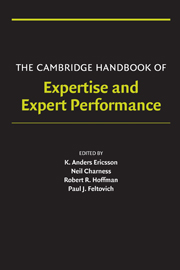Book contents
- Frontmatter
- Contents
- Acknowledgments
- Contributors
- PART I INTRODUCTION AND PERSPECTIVE
- PART II OVERVIEW OF APPROACHES TO THE STUDY OF EXPERTISE – BRIEF HISTORICAL ACCOUNTS OF THEORIES AND METHODS
- PART III METHODS FOR STUDYING THE STRUCTURE OF EXPERTISE
- PART IV METHODS FOR STUDYING THE ACQUISITION AND MAINTENANCE OF EXPERTISE
- PART V DOMAINS OF EXPERTISE
- PART VI GENERALIZABLE MECHANISMS MEDIATING EXPERTISE AND GENERAL ISSUES
- 34 A Merging Theory of Expertise and Intelligence
- 35 Tacit Knowledge, Practical Intelligence, and Expertise
- 36 Expertise and Situation Awareness
- 37 Brain Changes in the Development of Expertise: Neuroanatomical and Neurophysiological Evidence about Skill-Based Adaptations
- 38 The Influence of Experience and Deliberate Practice on the Development of Superior Expert Performance
- 39 Development and Adaptation of Expertise: The Role of Self-Regulatory Processes and Beliefs
- 40 Aging and Expertise
- 41 Social and Sociological Factors in the Development of Expertise
- 42 Modes of Expertise in Creative Thinking: Evidence from Case Studies
- Author Index
- Subject Index
- References
34 - A Merging Theory of Expertise and Intelligence
from PART VI - GENERALIZABLE MECHANISMS MEDIATING EXPERTISE AND GENERAL ISSUES
- Frontmatter
- Contents
- Acknowledgments
- Contributors
- PART I INTRODUCTION AND PERSPECTIVE
- PART II OVERVIEW OF APPROACHES TO THE STUDY OF EXPERTISE – BRIEF HISTORICAL ACCOUNTS OF THEORIES AND METHODS
- PART III METHODS FOR STUDYING THE STRUCTURE OF EXPERTISE
- PART IV METHODS FOR STUDYING THE ACQUISITION AND MAINTENANCE OF EXPERTISE
- PART V DOMAINS OF EXPERTISE
- PART VI GENERALIZABLE MECHANISMS MEDIATING EXPERTISE AND GENERAL ISSUES
- 34 A Merging Theory of Expertise and Intelligence
- 35 Tacit Knowledge, Practical Intelligence, and Expertise
- 36 Expertise and Situation Awareness
- 37 Brain Changes in the Development of Expertise: Neuroanatomical and Neurophysiological Evidence about Skill-Based Adaptations
- 38 The Influence of Experience and Deliberate Practice on the Development of Superior Expert Performance
- 39 Development and Adaptation of Expertise: The Role of Self-Regulatory Processes and Beliefs
- 40 Aging and Expertise
- 41 Social and Sociological Factors in the Development of Expertise
- 42 Modes of Expertise in Creative Thinking: Evidence from Case Studies
- Author Index
- Subject Index
- References
Summary
Creations, new insights, and paradigm shifts emerge at junctures where different theories – different world views – meet, come in conflict, and are forced to accommodate. So it can be with a theory of expertise and a theory of human intelligence. Over the course of 20th-century research, the developments of these two “world views” have run along separately, rather like Leibnitz's clocks, each addressing much the same question – what are the major capabilities of the human and how do they come about – but neither speaking to the other. They have arrived at different conclusions, neither thoroughly correct, of course, but neither entirely wrong either. Now, we reason, if we put the two theories in newly-met dialog, we can drive off the odious irrelevancies of each in a distillation that captures the truthful essence of both – a new liquor: a theory that is more accurate than any that has gone before. That, immodestly, is what we present in what follows.
We deal with the question of how expertise fits within that part of human personality we describe with a theory of human intelligence. Thus, the larger perspective is that of personality – a theory that describes what people do and explains why they do it. The principal descriptive concept of this theory is behavioral trait, a characteristic that persistently distinguishes one individual from another despite variation in the circumstances in which individuals are found.
- Type
- Chapter
- Information
- The Cambridge Handbook of Expertise and Expert Performance , pp. 587 - 612Publisher: Cambridge University PressPrint publication year: 2006
References
- 21
- Cited by



